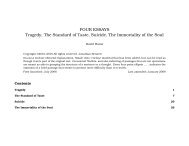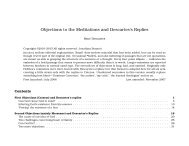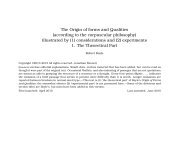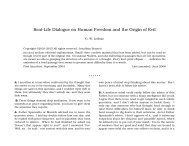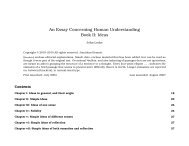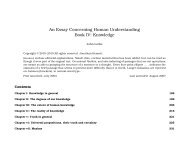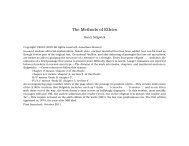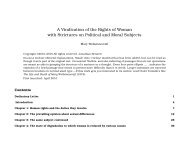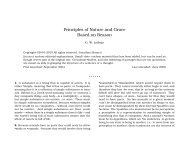The Form and Principles of the Sensible and Intelligible World
The Form and Principles of the Sensible and Intelligible World
The Form and Principles of the Sensible and Intelligible World
Create successful ePaper yourself
Turn your PDF publications into a flip-book with our unique Google optimized e-Paper software.
<strong>The</strong> <strong>Sensible</strong> <strong>and</strong> <strong>Intelligible</strong> <strong>World</strong> Immanuel Kant V: Sensitive <strong>and</strong> <strong>the</strong> intellectual in metaphysics<br />
Any such axiom would be spurious <strong>and</strong> rashly <strong>and</strong> hazardously<br />
asserted, if not outright false. Here is why: since S<br />
is conceived intellectually it pertains to •<strong>the</strong> object, whereas<br />
P (since it involves space <strong>and</strong> time) pertains only to •<strong>the</strong><br />
conditions <strong>of</strong> sensitive human knowledge; perhaps that isn’t<br />
<strong>the</strong> only kind <strong>of</strong> knowledge; <strong>and</strong> if it isn’t, <strong>the</strong>n P doesn’t<br />
cover <strong>the</strong> whole territory <strong>and</strong> thus doesn’t grip onto S itself.<br />
And <strong>the</strong> reason why <strong>the</strong> intellect is so easily subject to this<br />
fallacy <strong>of</strong> switching is that it is led astray by <strong>the</strong> authority <strong>of</strong><br />
a certain o<strong>the</strong>r rule that is utterly genuine:<br />
If something can’t be known by any intuition at all,<br />
that means that it is unthinkable <strong>and</strong> thus impossible.<br />
Now, we can’t by any effort <strong>of</strong> <strong>the</strong> mind •have or even<br />
•imagine any intuition except <strong>the</strong> one that fits <strong>the</strong> form <strong>of</strong><br />
space <strong>and</strong> time. So we are led to regard every intuition that<br />
isn’t spatio-temporal—e.g. God’s pure intellectual intuition.<br />
which Plato calls an ‘Idea’—as impossible. And so we subject<br />
all possible things to <strong>the</strong> sensitive axioms <strong>of</strong> space <strong>and</strong> time.<br />
26. [<strong>The</strong> items in <strong>the</strong> following three-part classification are <strong>the</strong> topics<br />
<strong>of</strong> 27, 28 <strong>and</strong> 29 respectively. After that, 30 brings <strong>the</strong> work to a close.]<br />
Switching axioms arise from illusions in which sensitive<br />
cognition masquerades as intellectual knowledge. ·<strong>The</strong>re are<br />
many such illusions, but· <strong>the</strong>y fall into three kinds. Here are<br />
<strong>the</strong>ir general formulae:<br />
(1) <strong>The</strong> sensitive condition that has to be satisfied if it’s<br />
to be possible to have an intuition <strong>of</strong> an object is also<br />
a necessary condition for <strong>the</strong> possibility <strong>of</strong> <strong>the</strong> object.<br />
(2) <strong>The</strong> sensitive condition that has to be satisfied if it’s to<br />
be possible to collect <strong>and</strong> survey facts about an object<br />
7<br />
so as to form an intellectual concept <strong>of</strong> it is also a<br />
necessary condition for <strong>the</strong> possibility <strong>of</strong> <strong>the</strong> object.<br />
(3) <strong>The</strong> sensitive condition that has to be satisfied if<br />
it’s to be possible to bring an object under a given<br />
intellectual concept is also a necessary condition for<br />
<strong>the</strong> possibility <strong>of</strong> <strong>the</strong> object.<br />
27. Here’s a switching axiom <strong>of</strong> class (1): Whatever exists is<br />
somewhere <strong>and</strong> somewhen. 7 This spurious principle implies<br />
that all entities—even if <strong>the</strong>y were known intellectually—are<br />
bound in <strong>the</strong>ir existence by <strong>the</strong> conditions <strong>of</strong> space <strong>and</strong> time.<br />
An upshot <strong>of</strong> this was that empty questions were b<strong>and</strong>ied<br />
about concerning where in <strong>the</strong> corporeal universe immaterial<br />
substances are located, where <strong>the</strong> seat <strong>of</strong> <strong>the</strong> soul is, <strong>and</strong> so<br />
on. (·How did immaterial substances enter <strong>the</strong> picture·? Well,<br />
<strong>the</strong>y have something in common with intellectual things,<br />
namely that nei<strong>the</strong>r is given in sensitive intuition <strong>and</strong> nei<strong>the</strong>r<br />
can be represented in that ·spatial· form; so <strong>the</strong>y are mixed<br />
toge<strong>the</strong>r—a jumble <strong>of</strong> immaterial substances <strong>and</strong> intellectual<br />
items, like a jumble <strong>of</strong> squares <strong>and</strong> circles.) <strong>The</strong>se disputes<br />
have been so empty that (as <strong>the</strong> old saying has it) it <strong>of</strong>ten<br />
looked as though one disputant was milking a he-goat while<br />
<strong>the</strong> o<strong>the</strong>r held a sieve underneath. Immaterial things are<br />
virtually present in <strong>the</strong> corporeal but not locally present, ·i.e.<br />
<strong>the</strong>y are active in <strong>the</strong> corporeal world but aren’t located in it·.<br />
Now, <strong>the</strong> only interactions that space allows for is between<br />
material bodies. <strong>The</strong>n what constitutes <strong>the</strong> external relations<br />
<strong>of</strong> forces between immaterial substances, <strong>and</strong> between <strong>the</strong>m<br />
<strong>and</strong> bodies, completely escapes <strong>the</strong> human intellect. . . .<br />
Space <strong>and</strong> time are conceived as embracing everything that meets <strong>the</strong> senses in any way. <strong>The</strong> laws <strong>of</strong> <strong>the</strong> human mind don’t allow it any intuition<br />
<strong>of</strong> something not contained in space <strong>and</strong> time. We can compare this first switching axiom with something that isn’t strictly a switching axiom but<br />
ra<strong>the</strong>r a trick <strong>of</strong> <strong>the</strong> imagination: Whatever exists has space <strong>and</strong> time IN it, meaning that every substance is extended <strong>and</strong> continually changing.<br />
Broad-brush thinkers are tied down by this law <strong>of</strong> <strong>the</strong> imagination, but even <strong>the</strong>y easily see that it applies only to <strong>the</strong> imagination’s efforts give an<br />
outline <strong>of</strong> <strong>the</strong> appearance <strong>of</strong> things, <strong>and</strong> doesn’t apply to <strong>the</strong> conditions <strong>of</strong> existence.<br />
21




